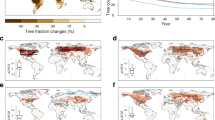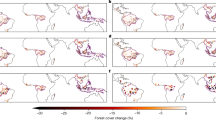Abstract
More than 20% of the Amazon rainforest has been cleared in the past three decades1, triggering important hydroclimatic changes1,2,3,4,5,6. Small-scale (a few kilometres) deforestation in the 1980s has caused thermally triggered atmospheric circulations7 that increase regional cloudiness8,9,10 and precipitation frequency8. However, these circulations are predicted to diminish as deforestation increases11,12,13. Here we use multi-decadal satellite records14,15 and numerical model simulations to show a regime shift in the regional hydroclimate accompanying increasing deforestation in Rondônia, Brazil. Compared with the 1980s, present-day deforested areas in downwind western Rondônia are found to be wetter than upwind eastern deforested areas during the local dry season. The resultant precipitation change in the two regions is approximately ±25% of the deforested area mean. Meso-resolution simulations robustly reproduce this transition when forced with increasing deforestation alone, showing that large-scale climate variability plays a negligible role16. Furthermore, deforestation-induced surface roughness reduction is found to play an essential role in the present-day dry-season hydroclimate. Our study illustrates the strong scale sensitivity of the climatic response to Amazonian deforestation and suggests that deforestation is sufficiently advanced to have caused a shift from a thermally to a dynamically driven hydroclimatic regime.
This is a preview of subscription content, access via your institution
Access options
Access Nature and 54 other Nature Portfolio journals
Get Nature+, our best-value online-access subscription
$29.99 / 30 days
cancel any time
Subscribe to this journal
Receive 12 print issues and online access
$209.00 per year
only $17.42 per issue
Buy this article
- Purchase on Springer Link
- Instant access to full article PDF
Prices may be subject to local taxes which are calculated during checkout





Similar content being viewed by others
References
Davidson, E. A. et al. The Amazon basin in transition. Nature 481, 321–328 (2012).
Gash, J. H. C., Nobre, C. A., Roberts, J. M. & Victoria, R. L. Amazonian Deforestation and Climate (John Wiley, 1996).
von Randow, C. et al. Comparative measurements and seasonal variations in energy and carbon exchange over forest and pasture in South West Amazonia. Theor. Appl. Climatol. 78, 5–26 (2004).
D’Almeida, C. et al. The effects of deforestation on the hydrological cycle in Amazonia: a review on scale and resolution. Int. J. Climatol. 27, 633–647 (2007).
Lawrence, D. & Vandecar, K. Effects of tropical deforestation on climate and agriculture. Nat. Clim. Change 5, 27–36 (2014).
Nobre, C. A. et al. Land-use and climate change risks in the Amazon and the need of a novel sustainable development paradigm. Proc. Natl Acad. Sci. USA 113, 10759–10768 (2016).
Roy, S. B. & Avissar, R. Impact of land use/land cover change on regional hydrometeorology in Amazonia. J. Geophys. Res. 107, LBA 4-1–LBA 4-12 (2002).
Chagnon, F. J. F. & Bras, R. L. Contemporary climate change in the Amazon. Geophys. Res. Lett. 32, L13703 (2005).
Negri, A. J., Adler, R. F., Xu, L. M. & Surratt, J. The impact of Amazonian deforestation on dry season rainfall. J. Clim. 17, 1306–1319 (2004).
Wang, J. F. et al. Impact of deforestation in the Amazon basin on cloud climatology. Proc. Natl Acad. Sci. USA 106, 3670–3674 (2009).
Avissar, R. & Schmidt, T. An evaluation of the scale at which ground-surface heat flux patchiness affects the convective boundary layer using large-eddy simulations. J. Atmos. Sci. 55, 2666–2689 (1998).
Patton, E. G., Sullivan, P. P. & Moeng, C. H. The influence of idealized heterogeneity on wet and dry planetary boundary layers coupled to the land surface. J. Atmos. Sci. 62, 2078–2097 (2005).
Khanna, J. & Medvigy, D. Strong control of surface roughness variations on the simulated dry season regional atmospheric response to contemporary deforestation in Rondônia, Brazil. J. Geophys. Res. 119, 13067–13078 (2014).
Knapp, K. R. et al. Globally gridded satellite observations for climate studies. Bull. Am. Meteorol. Soc. 92, 893–907 (2011).
Ashouri, H. et al. PERSIANN-CDR Daily precipitation Climate Data Record from multisatellite observations for hydrological and climate studies. Bull. Am. Meteorol. Soc. 96, 69–83 (2015).
Fernandes, K., Giannini, A., Verchot, L., Baethgen, W. & Pinedo-Vasquez, M. Decadal covariability of Atlantic SSTs and western Amazon dry-season hydroclimate in observations and CMIP5 simulations. Geophys. Res. Lett. 42, 6793–6801 (2015).
Rossow, W. B. & Garder, L. C. Cloud detection using satellite measurements of infrared and visible radiances for ISCCP. J. Clim. 6, 2341–2369 (1993).
Roberts, D. A. et al. LBA-ECO ND-01 Landsat 28.5-m Land Cover Time Series, Rondônia, Brazil: 1984–2010 Oak Ridge National Laboratory Distributed Active Archive Center (2013); http://dx.doi.org/10.3334/ORNLDAAC/1165
Fu, R. & Li, W. The influence of the land surface on the transition from dry to wet season in Amazonia. Theoret. Appl. Climatol. 78, 97–110 (2004).
Yin, L. et al. What controls the interannual variation of the wet season onsets over the Amazon? J. Geophys. Res. 119, 2314–2328 (2014).
Boyce, C. K. & Lee, J. E. An exceptional role for flowering plant physiology in the expansion of tropical rainforests and biodiversity. Proc. R. Soc. B 277, 3437–3443 (2010).
Swann, A. L. S., Longo, M., Knox, R. G., Lee, E. & Moorcroft, P. R. Future deforestation in the Amazon and consequences for South American climate. Agric. For. Meteorol. 214, 12–24 (2015).
Nobre, C. A. & Borma, L. D. S. ‘Tipping points’ for the Amazon forest. Curr. Opin. Environ. Sustain. 1, 28–36 (2009).
Brando, P. M. et al. Abrupt increases in Amazonian tree mortality due to drought-fire interactions. Proc. Natl Acad. Sci. USA 111, 6347–6352 (2014).
Huffman, G. J. & Bolvin, D. T. TRMM and Other Precipitation Data Set Documentation 1–40 (NASA, 2014).
Demaria, E. M. C. et al. Evaluation of mesoscale convective systems in South America using multiple satellite products and an object-based approach. J. Geophys. Res. 116, D08103 (2011).
Walko, R. L. & Avissar, R. The ocean-land-atmosphere-model (OLAM). Part I: shallow-water tests. Month. Weath. Rev. 136, 4033–4044 (2008).
van Heerwaarden, C. C. & de Arellano, J. V. G. Relative humidity as an indicator for cloud formation over heterogeneous land surfaces. J. Atmos. Sci. 65, 3263–3277 (2008).
Saleska, S. R. et al. LBA-ECO CD-32 Flux Tower Network Data Compilation, Brazilian Amazon: 1999–2006 Oak Ridge National Laboratory Distributed Active Archive Center (2013); http://dx.doi.org/10.3334/ORNLDAAC/1174
Spracklen, D. V., Arnold, S. R. & Taylor, C. M. Observations of increased tropical rainfall preceded by air passage over forests. Nature 489, 282-U127 (2012).
Walker, R. et al. Protecting the Amazon with protected areas. Proc. Natl Acad. Sci. USA 106, 10582–10586 (2009).
Prodes Monitoramento da Florsta Amazonica Brasileira por Satélite Prodes (Instituto Nacional de Pesquisas Espaciais, 2015); http://www.obt.inpe.br/prodes
Wang, J. F., Bras, R. L. & Eltahir, E. A. B. The impact of observed deforestation on the mesoscale distribution of rainfall and clouds in Amazonia. J. Hydrometeorol. 1, 267–286 (2000).
Knapp, K. R. & NOAA CDR Program. NOAA Climate Data Record (CDR) of Gridded Satellite Data from ISCCP B1 (GridSat-B1) 11 micron Brightness Temperature, Version 2 NOAA National Climatic Data Center (accessed January 2015); http://dx.doi.org/10.7289/V59P2ZKR
Rayner, N. A. et al. Global analyses of sea surface temperature, sea ice, and night marine air temperature since the late nineteenth century. J. Geophys. Res. 108, 4407 (2003).
Kalnay, E. et al. The NCEP/NCAR 40-year reanalysis project. Bull. Am. Meteorol. Soc. 77, 437–471 (1996).
Kato, S. et al. Surface irradiances consistent with CERES-derived top-of-atmosphere shortwave and longwave irradiances. J. Clim. 26, 2719–2740 (2013).
Fisch, G. et al. The convective boundary layer over pasture and forest in Amazonia. Theoret. Appl. Climatol. 78, 47–59 (2004).
Hsu, K. L. & Sorooshian, S. Satellite based precipitation measurement using PERSIANN system. Water Sci. Technol. Libr. 63, 27–48 (2008).
de Goncalves, L. G. G. et al. Evaluation of model-derived and remotely sensed precipitation products for continental South America. J. Geophys. Res. 111, D16113 (2006).
Sorooshian, S., Hsu, K., Braithwaite, D. & Ashouri, H. NOAA CDR Program. NOAA Climate Data Record (CDR) of Precipitation Estimation from Remotely Sensed Information using Artificial Neural Networks (PERSIANN-CDR), Version 1 Revision 1 NOAA National Centers for Environmental Information (accessed 24 March 2016); http://dx.doi.org/10.7289/V51V5BWQ
Acknowledgements
D.M. acknowledges support from National Science Foundation Award 1151102. R.W. acknowledges support from National Science Foundation Award 0902197. The simulations presented in this article were performed on computational resources supported by the PICSciE OIT High Performance Computing Center and Visualization Laboratory at Princeton University. We also acknowledge helpful correspondence with K. R. Knapp at NOAA, Asheville, North Carolina.
Author information
Authors and Affiliations
Contributions
J.K. and D.M. initiated the project, designed the research and drafted the manuscript. J.K. carried out the research. S.F. contributed ideas to the research design, data analysis and the manuscript. R.W. contributed ideas to the simulation design, simulated data analysis and the manuscript.
Corresponding author
Ethics declarations
Competing interests
The authors declare no competing financial interests.
Supplementary information
Supplementary Information
Supplementary Information (PDF 4796 kb)
Rights and permissions
About this article
Cite this article
Khanna, J., Medvigy, D., Fueglistaler, S. et al. Regional dry-season climate changes due to three decades of Amazonian deforestation. Nature Clim Change 7, 200–204 (2017). https://doi.org/10.1038/nclimate3226
Received:
Accepted:
Published:
Issue Date:
DOI: https://doi.org/10.1038/nclimate3226
This article is cited by
-
Tropical deforestation causes large reductions in observed precipitation
Nature (2023)
-
International corporations trading Brazilian soy are keystone actors for water stewardship
Communications Earth & Environment (2023)
-
Land use still matters after deforestation
Communications Earth & Environment (2023)
-
Impacts of the land use and land-cover changes on local hydroclimate in southwestern Amazon
Climate Dynamics (2023)
-
Rising ecosystem water demand exacerbates the lengthening of tropical dry seasons
Nature Communications (2022)



